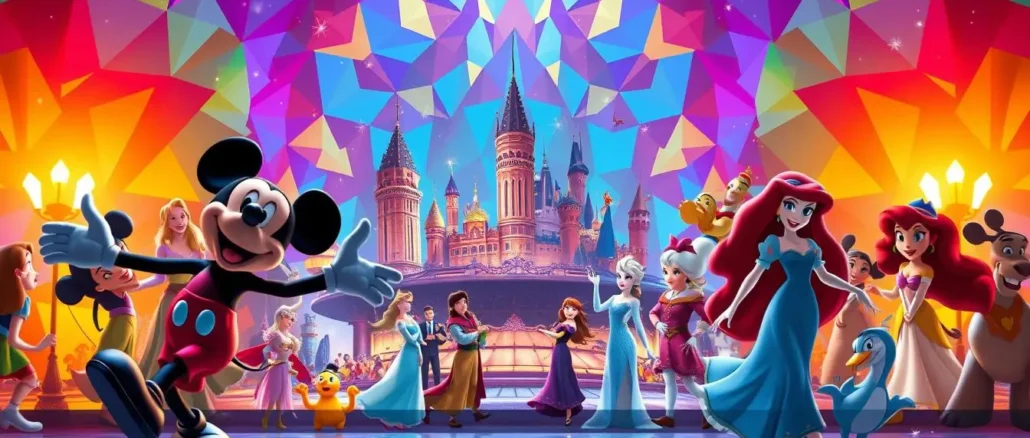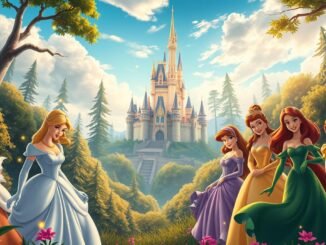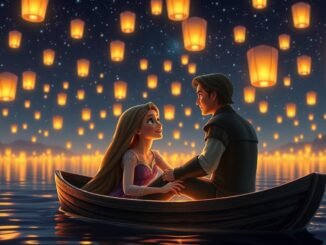
The world of Walt Disney is a realm of wonder and enchantment, captivating audiences worldwide with its timeless stories and memorable characters.
From its humble beginnings to its current status as a global entertainment leader, the Disney brand has evolved significantly over the years, leaving an indelible mark on popular culture.
The magic of Disney continues to inspire new generations, making it a fascinating subject to explore, delving into its rich Disney history and the impact it has had on the entertainment industry.
Key Takeaways
- The Walt Disney company has a rich history that spans nearly a century.
- Disney’s impact on popular culture is undeniable, with its characters and stories becoming a part of our shared heritage.
- The Disney brand has evolved significantly over the years, expanding into new areas such as theme parks and digital media.
- The magic of Disney continues to inspire new generations, with its timeless stories and memorable characters.
- Disney’s influence can be seen in many areas, from film and television to merchandise and tourism.
The Legacy of Walt Disney: A Brief Overview
Born in 1901, Walt Disney’s life was a journey of creativity and innovation that would change the face of animation forever. His legacy is a testament to his entrepreneurial drive and the impact he had on the entertainment industry.
Early Life and Influences
Walt Disney’s early life played a significant role in shaping his future endeavors. Growing up in a family that encouraged creativity, Disney developed an interest in drawing at an early age. He began selling his sketches to neighbors and eventually moved to Kansas City, where he began his career as an animator.
Disney’s time in France during World War I as an ambulance driver exposed him to various artistic influences, which later shaped his animation style. Upon returning to the United States, Disney settled in Kansas City, where he founded his first animation company, Laugh-O-Gram Studio.
Founding of the Disney Studio
In 1923, Walt Disney founded the Disney Brothers Cartoon Studio with his brother, Roy, in Los Angeles. The studio’s early success came with the creation of Oswald the Lucky Rabbit. However, due to a contract dispute, Disney lost the rights to Oswald. This setback led to the creation of Mickey Mouse, one of the most iconic characters in animation history.
The Disney Studio continued to grow, and by the late 1920s, Disney had established himself as a leader in the animation industry. The introduction of sound in animation with Steamboat Willie in 1928 marked a significant milestone for the studio.
Revolutionary Animation Techniques
Walt Disney was known for pushing the boundaries of animation. The introduction of the multiplane camera, which allowed for greater depth and visual complexity, was a significant innovation. This technique was first used in The Old Mill (1937), a Silly Symphonies short film.
Disney’s commitment to innovation led to the development of the first full-length animated feature film, Snow White and the Seven Dwarfs (1937). This groundbreaking film set a new standard for animation and storytelling, cementing Disney’s position as a pioneer in the industry.
The legacy of Walt Disney continues to inspire new generations of animators, filmmakers, and audiences worldwide. His impact on the entertainment industry is immeasurable, and his innovative spirit remains a driving force behind the Disney studio’s continued success.
Iconic Characters and Their Impact
The magic of Disney lies in its iconic characters, which have left a lasting impact on popular culture. These characters have become an integral part of our shared cultural heritage, captivating audiences worldwide with their timeless appeal.
The Origins of Mickey Mouse
Mickey Mouse, one of Disney’s most iconic characters, was created in 1928 by Walt Disney and Ub Iwerks. Initially named “Mortimer Mouse,” Mickey was later renamed by Walt Disney’s wife, Lillian. Mickey’s debut in Steamboat Willie marked a significant milestone in animation history, as it was one of the first cartoons to feature synchronized sound.
Mickey’s impact on popular culture cannot be overstated. He has become a symbol of Disney, representing the brand’s values of joy, innocence, and nostalgia. Over the years, Mickey has undergone several transformations, adapting to changing times while retaining his core charm.
Evolution of Disney Princesses
The Disney Princesses have evolved significantly since the release of Snow White and the Seven Dwarfs in 1937. From Snow White to modern princesses like Elsa and Anna from Frozen, the portrayal of princesses has reflected changing societal values and cultural norms.
Early Disney Princesses were often depicted as damsels in distress, relying on princes for rescue. However, modern princesses are more independent, strong-willed, and proactive, reflecting the changing roles of women in society. This evolution has helped keep the Disney Princess franchise relevant and appealing to new generations.
Cultural Significance of Disney Characters
Disney characters have transcended their roles as mere entertainment figures, becoming cultural icons that influence societal values and norms. Characters like Mickey Mouse and the Disney Princesses have been used in various contexts, from education to marketing, due to their widespread recognition and appeal.
The cultural significance of Disney characters is also reflected in their ability to evoke nostalgia and create a sense of shared experience among audiences worldwide. As Disney continues to create new characters and stories, the impact of these iconic figures on popular culture will only continue to grow.
Walt Disney’s Theme Parks: A Magical Experience
Walt Disney’s dream of creating enchanting environments for families resulted in the establishment of Disneyland, a pioneering theme park. This vision not only captivated audiences but also revolutionized the entertainment industry by setting new standards for immersive experiences.
The Original Magic Kingdom
Disneyland, opened in 1955 in Anaheim, California, was Walt Disney’s first foray into theme park entertainment. It introduced several innovative concepts, including themed lands and attractions that transported visitors into fantastical worlds. The success of Disneyland was a testament to Walt Disney’s innovative approach to entertainment.
Innovative Features of Disneyland:
- Themed lands such as Adventureland and Tomorrowland
- Iconic attractions like “It’s a Small World” and “Sleeping Beauty Castle”
- Immersive experiences that combined technology and storytelling
Expanding the Vision
Walt Disney World in Florida, which opened in 1971, was a significant expansion of Walt Disney’s theme park vision. Although Walt Disney passed away before its completion, his legacy lived on through the expansive resort that included multiple theme parks and amenities. Walt Disney World represented a significant step forward in theme park design, with larger scale and more sophisticated attractions.
Key Features of Walt Disney World:
| Feature | Description |
|---|---|
| Magic Kingdom | The first and most iconic of the Walt Disney World theme parks, inspired by Disneyland |
| Epcot | A celebration of innovation, culture, and technological advancements from around the world |
| Hollywood Studios | Dedicated to the world of movies, television, and music |
| Animal Kingdom | Focusing on wildlife conservation and the wonders of the natural world |
Innovations in Theme Park Design
Walt Disney’s theme parks have been at the forefront of innovation, continually pushing the boundaries of what is possible in entertainment. From the use of Audio-Animatronics to the incorporation of immersive technologies, Disney has maintained its position as a leader in theme park design.
The impact of these innovations can be seen in the evolution of theme park attractions, which have become increasingly sophisticated over the years. The use of advanced technologies has enabled the creation of more immersive and engaging experiences, further enhancing the magic of Disney’s theme parks.
The Evolution of Disney Media
Over the years, Disney has diversified its media content to cater to a wider audience. The Walt Disney Company has been a pioneer in the entertainment industry, constantly adapting to changing audience preferences and technological advancements.
Timeless Animated Classics
Disney’s animated classics have stood the test of time, remaining beloved by audiences worldwide. Films like Snow White and the Seven Dwarfs and The Lion King continue to captivate new generations. The studio’s commitment to quality animation and storytelling has been a key factor in its success.
Some of the key features that contribute to the timelessness of Disney’s animated classics include:
- Memorable characters and storylines
- Iconic music and soundtracks
- Innovative animation techniques
Transition to Live-Action Films
In recent years, Disney has expanded its portfolio to include live-action films, reimagining classic tales and creating new ones. Movies like The Jungle Book and Beauty and the Beast have achieved significant commercial success, demonstrating the studio’s ability to adapt to changing audience preferences.
The transition to live-action films has also allowed Disney to explore new themes and genres, further diversifying its content offerings.
Impact of Streaming Services
The rise of streaming services has significantly impacted Disney’s distribution strategy. The launch of Disney+ has provided the company with a new platform to showcase its vast library of content, including classic films and exclusive originals.
Some of the key benefits of Disney’s streaming service include:
- Access to a vast library of Disney content
- Exclusive original content, including The Mandalorian and Encore!
- A user-friendly interface and personalized recommendations
Walt Disney’s Philanthropy and Social Influence
Walt Disney’s impact extends far beyond the realm of entertainment, as his philanthropic efforts have left a lasting legacy on global culture. The Disney magic that has captivated audiences worldwide is also reflected in the company’s charitable endeavors.
Education and Conservation Efforts
Disney has made significant contributions to education and conservation initiatives, supporting programs that promote environmental stewardship and artistic expression. The company’s commitment to conservation is evident in its efforts to protect natural habitats and promote eco-friendly practices within its theme parks.
Fostering Innovation and the Arts
The Disney legacy is also characterized by its support for innovation and the arts. By providing opportunities for emerging artists and filmmakers, Disney has helped to foster a new generation of creative talent. The company’s iconic Disney characters have become an integral part of popular culture, inspiring countless adaptations and reinterpretations.
The success of Disney’s theme parks, which have become beloved destinations around the world, is a testament to the enduring power of Disney magic. As a cultural phenomenon, Disney continues to captivate audiences and inspire new generations of fans.
FAQ
What is the history behind Walt Disney’s creation of Mickey Mouse?
Mickey Mouse was created in 1928 by Walt Disney and Ub Iwerks as a replacement for Oswald the Lucky Rabbit, a character Disney created for Universal Pictures. Mickey first appeared in the cartoon short “Steamboat Willie.”
What is the significance of Disneyland and Walt Disney World?
Disneyland, opened in 1955, was Walt Disney’s first theme park, revolutionizing the entertainment industry. Walt Disney World, opened in 1971, expanded on Disney’s vision, offering a larger and more diverse range of experiences, including the Magic Kingdom, Epcot, Hollywood Studios, and Animal Kingdom.
How has Disney’s animation studio evolved over the years?
Disney’s animation studio has evolved significantly, from its early days producing hand-drawn animated shorts to the current use of computer-generated imagery (CGI) and 3D animation. The studio has also expanded its reach through acquisitions, such as Pixar Animation Studios and 20th Century Animation.
What is the impact of Disney’s theme parks on the entertainment industry?
Disney’s theme parks have set a new standard for immersive entertainment experiences, influencing the design and operation of theme parks worldwide. The parks have also driven innovation in areas such as attractions, shows, and character meet-and-greets.
How has Disney adapted to the rise of streaming services?
Disney has successfully adapted to the rise of streaming services by launching its own platform, Disney+, which offers a vast library of Disney content, including classic films, recent releases, and original programming. This move has allowed Disney to reach a wider audience and compete in the rapidly evolving streaming market.
What is Walt Disney’s legacy in terms of philanthropy and social influence?
Walt Disney’s philanthropic efforts and social influence have had a lasting impact on global culture, with contributions to education, conservation, and the arts. The Walt Disney Company continues to support various charitable initiatives, reflecting Disney’s commitment to giving back to the community.
What are some of the most iconic Disney movies of all time?
Some of the most iconic Disney movies include “Snow White and the Seven Dwarfs,” “Pinocchio,” “Bambi,” “Cinderella,” “Sleeping Beauty,” “The Little Mermaid,” “Beauty and the Beast,” “The Lion King,” and “Frozen.”
How has Disney’s brand evolved over the years?
Disney’s brand has evolved significantly, from its early focus on animation and family entertainment to its current status as a global entertainment leader, encompassing film, television, theme parks, and consumer products. The brand continues to innovate and adapt to changing audience preferences.


